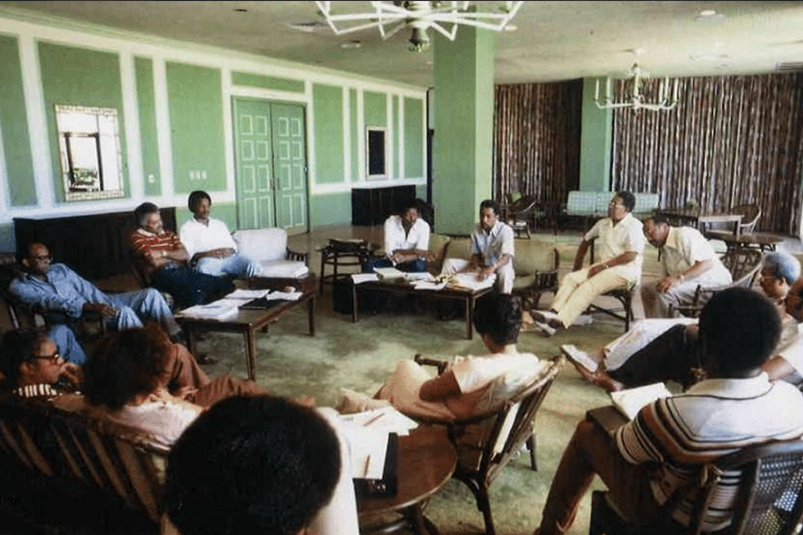During the 1968 American Institute of Architects (AIA) National Convention, activist and president of the National Urban League Whitney M. Young Jr. sharply rebuked the profession by stating: "You are not a profession that has distinguished itself by your social and civic contributions to the cause of civil rights … You are most distinguished by your thunderous silence and your complete irrelevance."
African American architects listened intently as Young reminded those present about the profession’s lack of social and civic contributions to the civil rights movement. Black architects in attendance had come from different parts of the country and did not know each other very well, but were all struck by Young’s words and recognized that the situation for black architects had to be improved.
Challenging the Status Quo
Three years later, 12 black architects who attended the 1971 AIA National Convention in Detroit decided to organize and change the status quo. During their first meeting, they discussed the desperate need for an organization dedicated to the development and advancement of black architects. Those present at that meeting included several black architecture students who were anxious to meet the visiting black architects.

Present for the creation of the National Organization of Minority Architects (NOMA) were William Brown, Leroy Campbell, Wendell Campbell, John S. Chase, James C. Dodd, Kenneth B. Groggs, Nelson Harris, Jeh Johnson, E.H. McDowell, Robert J. Nash, Harold Williams, and Robert Wilson.
A cruise to the Bahamas a few months later brought together NOMA’s 12 founding members and their wives for the group’s second meeting. Each wife was to play a crucial role in the running of the organization through their support of their husband’s assignments. A few weeks later, a third meeting was convened in Chicago where membership voted to accept the organization’s constitution as drawn up by Harold Williams and Jeh Johnson.
These architects wanted black design professionals to work together to fight discriminatory policies that limited or barred minority architects from participating in the AEC field. At early meetings, the members discussed various topics, including how to lobby Washington representatives to get black architects included in new legislation concerning work on federal projects, how to get AIA recognition for those most prominent among them (i.e., Paul Williams and Howard Mackey), and how to create their own design awards.
Strength in Unity
That was the beginning of NOMA, an increasingly influential voice, promoting the quality and excellence of minority design professionals. There are now 78 professional and student NOMA chapters in all parts of the country—increasing recognition on colleges and university campuses and providing greater access to government policymakers. The first NOMA president was Wendell Campbell, followed by several of the other founders.

Over time, some of NOMA’s founders and officers also served in AIA positions. In 1996, Cheryl McAfee, of Atlanta, became the first female president, followed by Roberta Washington, from New York, in 1997. From 2013 to 2014, NOMA was led by its third female president, Kathy Dixon. Kimberly Dowdell is NOMA's current president—making her the fourth female president in the organization's history.
Inspiring the Next Generation
Today, NOMA champions diversity within the design professions by promoting the excellence, community engagement, and professional development of its members. NOMA, which thrives on volunteer members who contribute their time and resources, strives to build a strong national organization, strong chapters, and strong members for the purpose of minimizing the effect of racism in the profession. NOMA’s strength is embodied by the unity that created the organization.
NOMA's membership has grown to 1,393—the highest membership in the organization's history. The organization has also served as a catalyst for Project Pipeline summer camps, where students are guided through all stages of design through provoking and fun exercises, ending the program with a fully realized project that addresses an issue in their city. In 2019, NOMA hosted over a dozen camps throughout the country, serving hundreds of students. More recently when the United States President Executive Order was released, NOMA President Dowdell issued a statement that framed the oppressive nature of the edict and echoed a claim to action.
Through its publications and conferences, NOMA demonstrates that minority professionals have the talent and capabilities to perform in design and construction with any other group. By building strong chapters of design professionals whose sensibilities and interests include promotion of urban communities, they are able to respond to the concerns that affect marginalized communities and people. One of their goals is to increase the level of participation in the social, political, and economic benefits afforded the citizens of this nation and to tear down the barriers that make full participation unattainable. Local chapters give members a base from which to be involved in politics, to visit schools and reach out to children, to conduct community and civic forums, and to responsibly practice in our professional capacities.
NOMA continues to inspire designers and architects and to claim their role in building an equitable profession and just world.
A version of this article originally appeared on NOMA’s website. The opinions expressed in this commentary are solely those of the author and do not necessarily reflect those of the National Council of Architectural Registration Boards (NCARB).